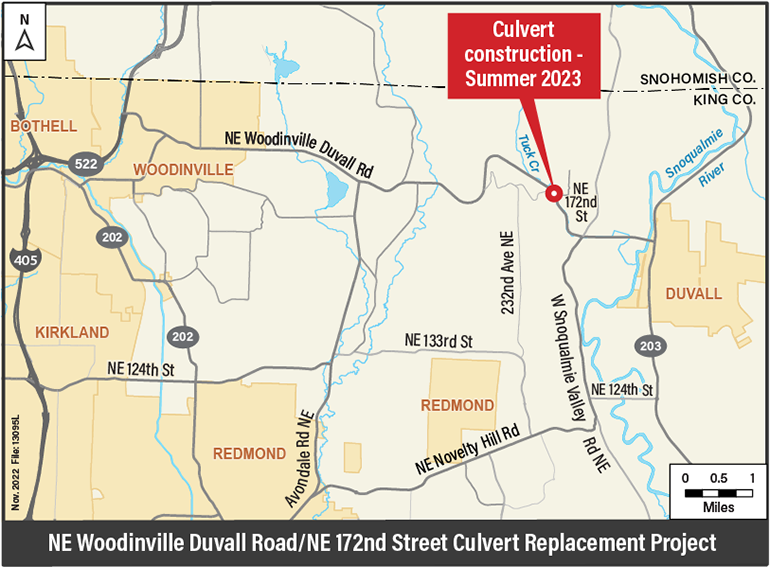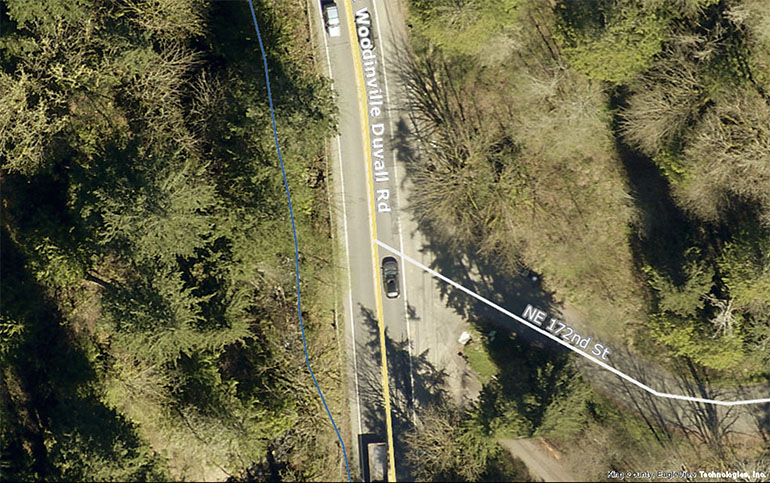NE Woodinville Duvall Road at NE 172nd Street Culvert Replacement Project
Project completed summer 2023
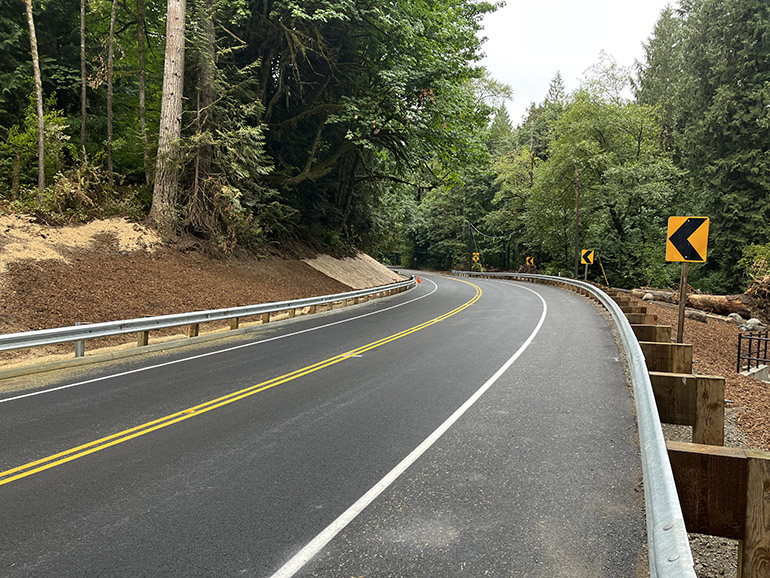
Check out the smooth surface of this freshly paved section of NE Woodinville Duvall Road above the new concrete box culvert.
Overview
King County replaced a narrow, worn-out metal pipe culvert with a much larger and wider concrete box culvert under NE Woodinville Duvall Road at NE 172nd Street. We also removed a concrete fish barrier downstream of the culvert and restored 235 feet of Tuck Creek with more natural habitat. The new culvert and creek habitat restoration is designed to move water through at its natural pace, just like a real stream.
NE Woodinville Duvall Road at NE 172nd Street was too narrow to have enough room for a large construction crane and other necessary equipment while safely maintaining even a single lane of alternating traffic through the work area.
The 40-day full road closure significantly reduced the total cost of the project and guaranteed both lanes of NE Woodinville Duvall Road were open in time to start the 2023/24 school year.
Why did King County replace this culvert?
We replaced the worn out, narrow metal culvert because it was rusted and failing.
The existing metal pipe culvert was nearing the end of its useful life and needed to be replaced. The old culvert was also considered a fish passage barrier. The new culvert is made of concrete and is also much wider to make it easier for fish to pass under the road.
This metal pipe culvert was considered a fish passage barrier for two main reasons:
- It was too small for the volume of water that passed through it. As a result, the water was pushed through extremely fast making it nearly impossible for fish to swim in it.
- At times, the water inside the existing culvert was too shallow and it was located too high above the stream bed for fish to jump into the culvert so they could not continue to swim upstream.
Fish have a very difficult time swimming through extremely swift water. They also have a lot of trouble jumping up and through a metal pipe with very little water in it.
Benefits of the concrete box culvert
A box culvert is flat and wide with streambed gravels placed in the bottom to simulate an actual stream allowing fish to move up and downstream easily. The new concrete box culvert makes it much easier for fish in Tuck Creek to pass under the roadway and continue their migration to Snoqualmie River.
- The box culvert can accommodate a much larger volume of water.
- It is designed to simulate a natural stream and allow consistent, gentle water flow under the road.
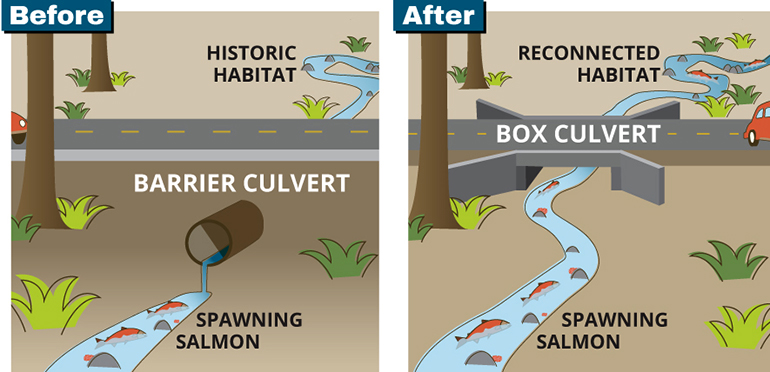
Fish have a hard time migrating upstream if there is not enough water in the culvert, or if the culvert is too high above the stream. The box culvert helps make it easier for fish to pass underneath the road. (Image courtesy of King County Fish Passage Program).
The following fish species are found in the Tuck Creek Basin:
- Chinook Salmon
- Coho Salmon
- Chum Salmon
- Pink Salmon
- Steelhead Trout
- Cutthoroat Trout
What is a fishway?
A fishway is a human-made concrete structure that helps provide easier access to migrating fish in a river or stream. The one removed had six ascending pools separated by concrete walls with an opening down the middle. The pools provided a place for fish to rest as they continued to swim against the current. The walls act to slow the rushing water that is forced out of the narrow pipe culvert. Now that the narrow pipe has been replaced with a wider concrete box culvert, there isn’t a need to slow the water down because the water flows through like a natural stream. We removed the existing fishway and replaced it with natural creek habitat.
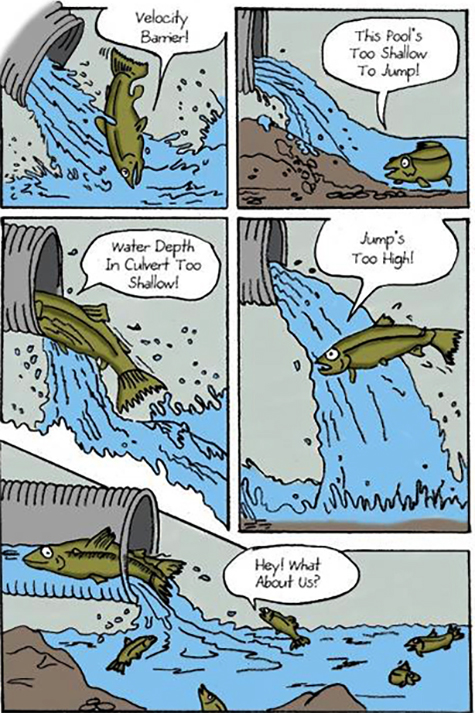
Culverts may block fish migration because the water flow is too swift, too shallow, or has a waterfall into or out of the culvert. The new box culvert is designed to have enough water running through it at a natural pace, just like a real stream. (Image courtesy of WSDOT Fish Passage Program).
An aerial view of the project location prior to construction. NE Woodinville Duvall Road at NE 172nd Street was closed for 40 days in a row, including weekends from July 17 through August 25, 2023. Larger view (354KB)
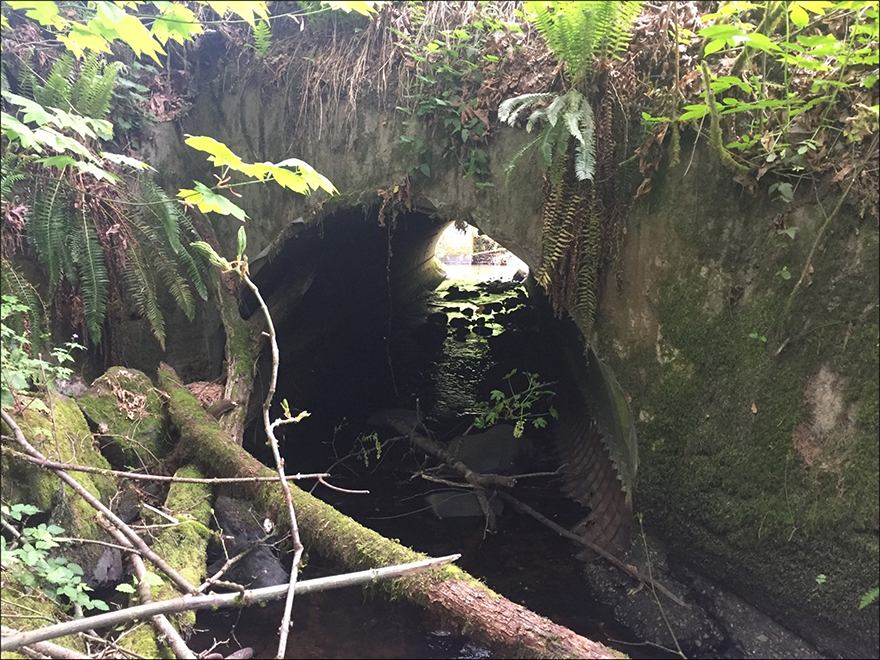
The old 8-foot-wide metal pipe culvert carried Tuck Creek under NE Woodinville Duvall Road (shown above). This culvert is a fish passage barrier and had outlived its useful life. The county replaced it with a much larger, fish-friendly box culvert in 2023.
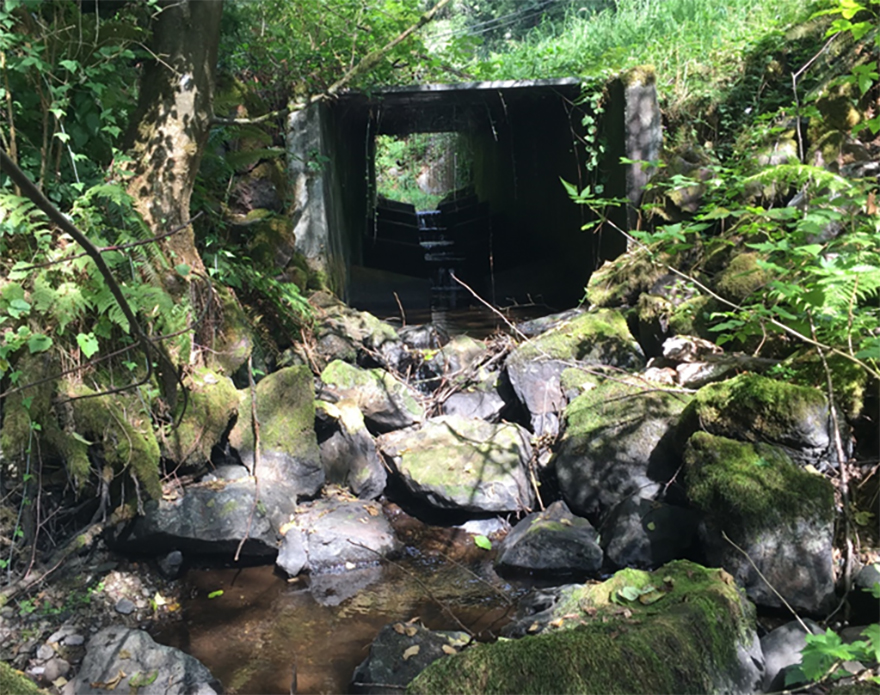
The project also removed the 50-foot-long concrete fishway barrier (above) and restored the creek so that fish migrating upstream don’t have to jump up and over the rocks. (Photo taken: September 2019)
Budget and funding sources
The total project cost is $4.5 million. This project is funded through the King County Fish Passage Program which is supported by local funding sources.
Photos
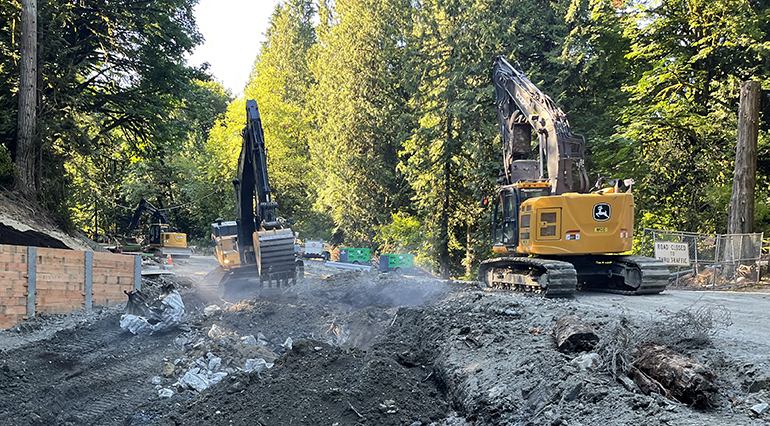
Work to dig out the old, failing culvert began in early August 2023 and took several days longer than anticipated to remove, which caused delays. This photo was taken on Aug. 1. The previous culvert was eventually fully removed on Aug. 7.
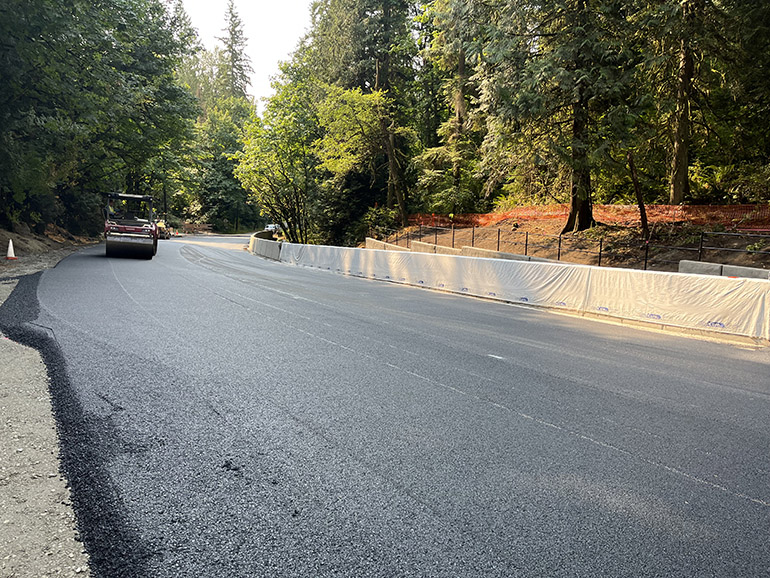
Aug. 23, 2023 – Crews roll over the smooth surface of the freshly paved section of NE Woodinville Duvall Road above the new concrete box culvert.
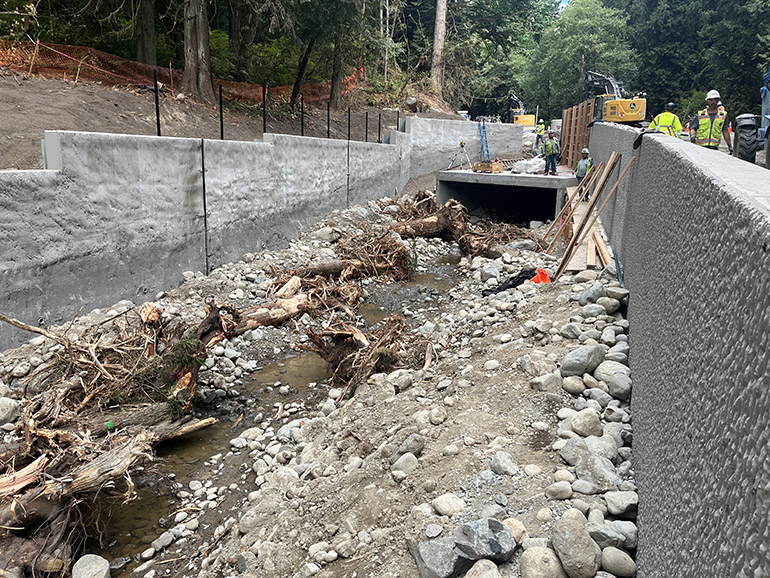
Aug. 22, 2023 – Trees and rocks fill the downstream section of Tuck Creek leading to the new box culvert. The new culvert and creek habitat restoration is designed to move water through at its natural pace, just like a natural stream.
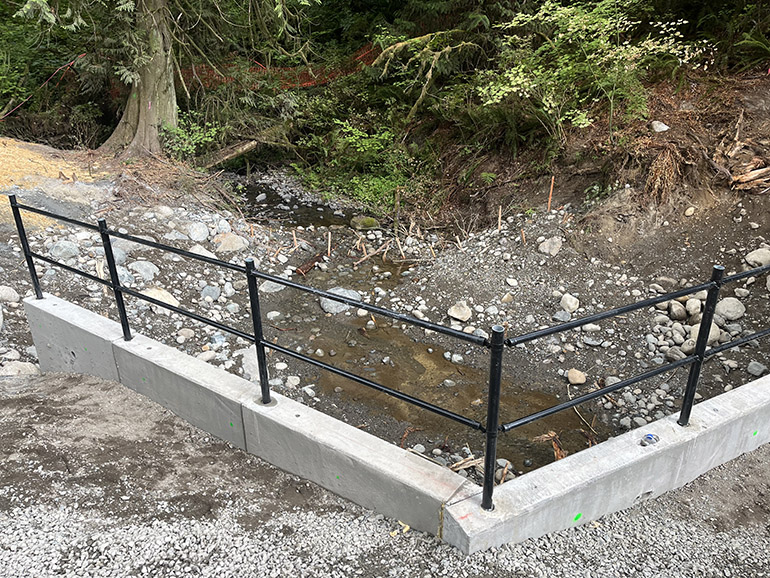
Aug. 23, 2023 – A view from above the new box culvert shows the safety guardrail with the creek flowing freely below it.
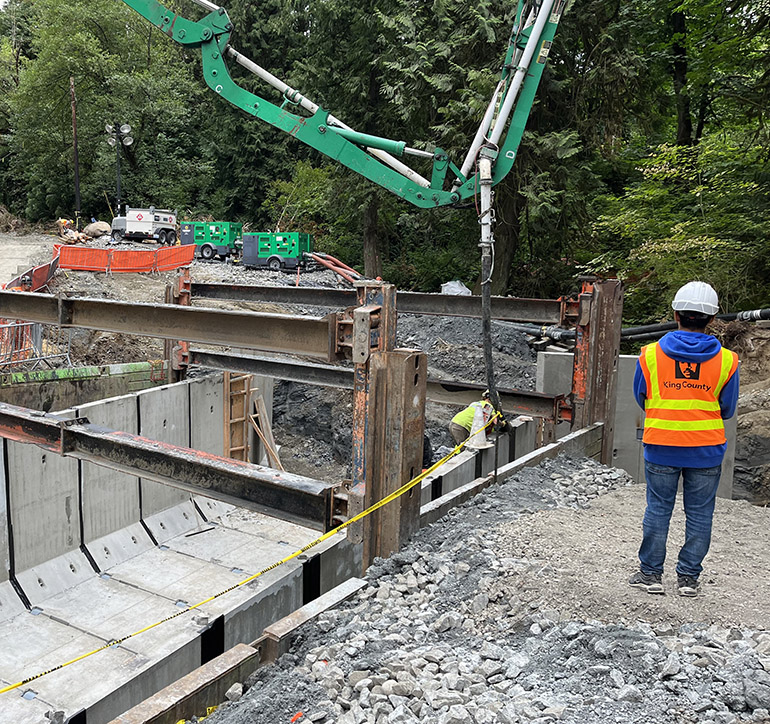
Aug. 10, 2023 - Our team made progress every day towards reopening NE Woodinville Duvall Road. The concrete is carefully poured between wall sections of the new culvert to secure them in place and prevent leaks.
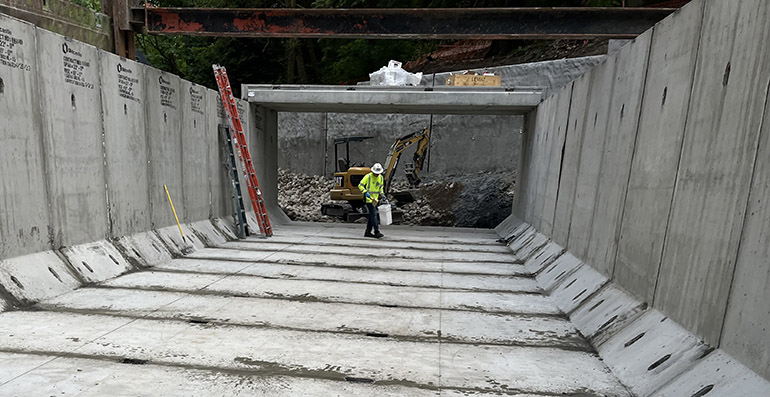
Aug. 10, 2023 - The walls and floor of the new box culvert are in place. Next crews will install the concrete lid which was placed by a crane. Once the culvert construction was complete, it was filled with dirt, gravel, rocks, and native plants to make a healthy habitat for fish and other creatures.
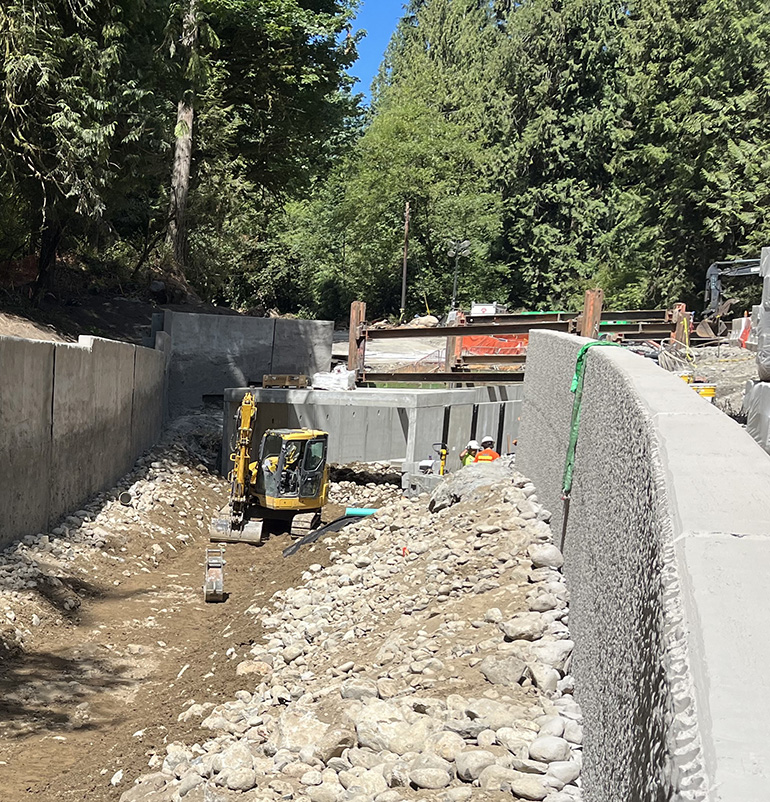
Aug. 11, 2023 - An excavator works to ready the new stream bed between the retaining walls on either side of the new box culvert. The bed was filled with dirt, gravel, rocks, and native plants.
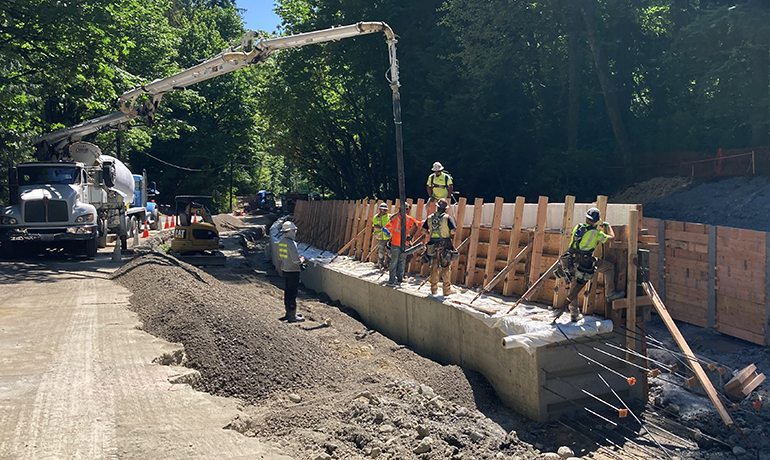
July 31, 2023 - It took several crewmembers to pour the concrete for the large retaining wall running along NE Woodinville Duvall Road .
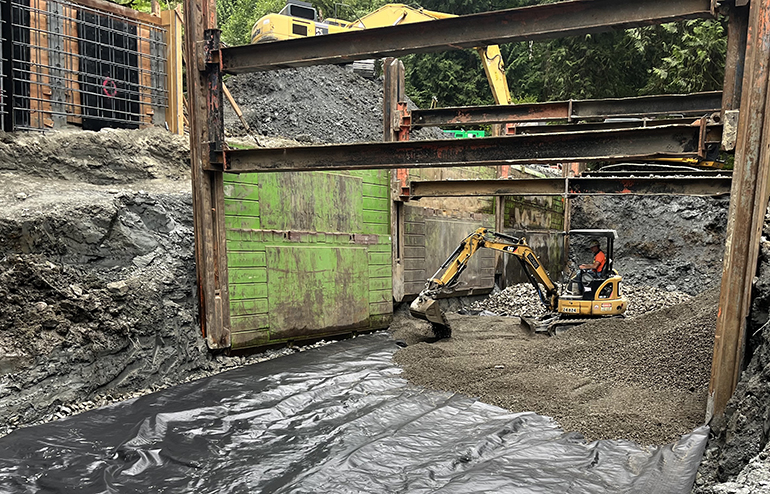
August 5, 2023 - A crewmember used a smaller excavator in the deep construction pit after shoring was placed to allow for construction of the foundation of the box culvert. The foundation is covered with a thick liner, rocks, and dirt to make a safe passageway for water and fish.
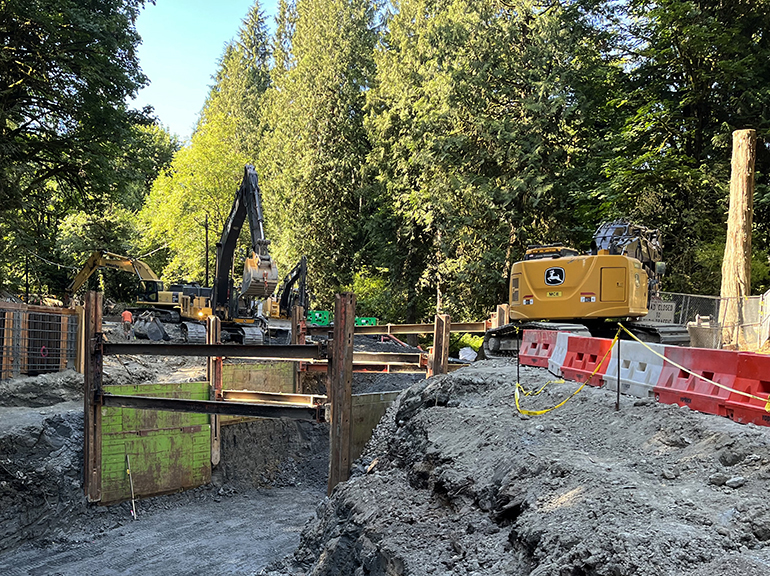
August 4, 2023 - Two large excavators sit at both sides of the large construction pit in the middle of NE Woodinville Duvall Road. This pit makes the road impassible so all travelers need to use the detour route.
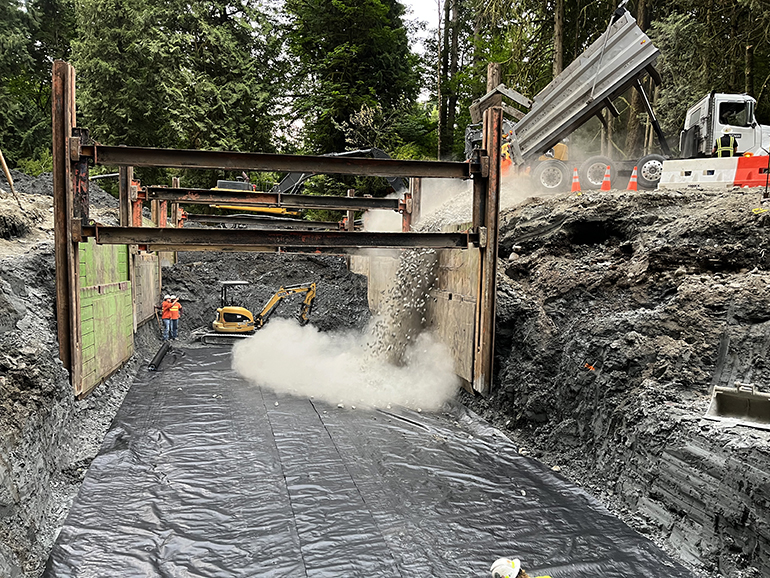
August 5, 2023 - A big truck dumped rocks into the bottom of the excavation to construct the foundation for the new box culvert.
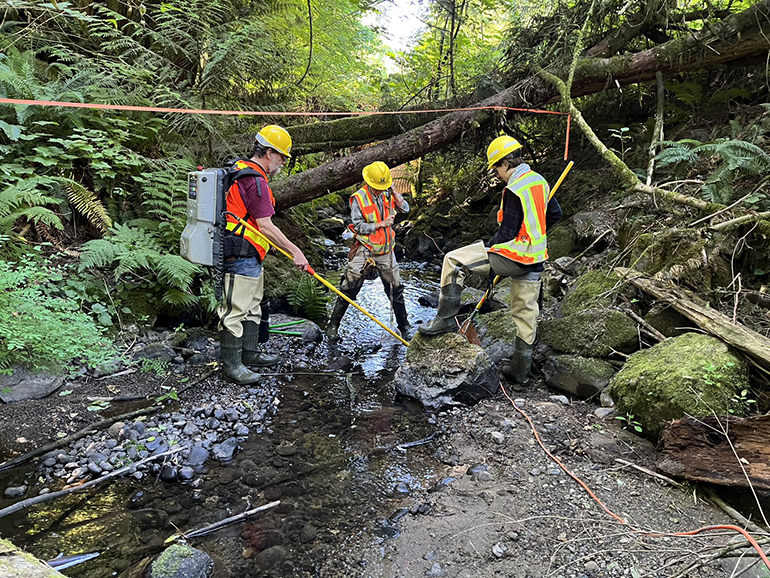
Environmental staff temporarily redirected fish away from the workzone so that crews can safely install a temporary stream diversion for fish to use during construction. Specialized crews catch and release fish downstream and then install a stream diversion to redirect fish until the project is complete. (Photo July 2023)
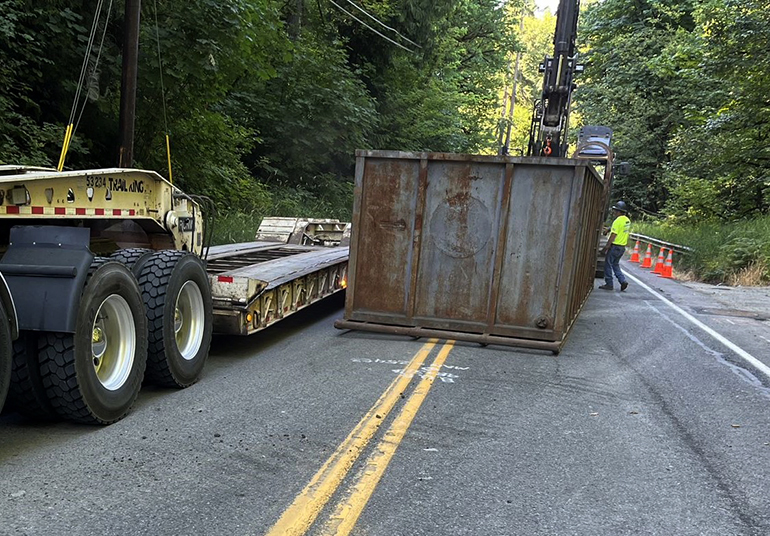
Crews installed a large four-chamber water cleaning and containment system known as a baker tank. The tank helps to keep the worksite dry and cleans the water around the construction zone. (Photo July 2023)
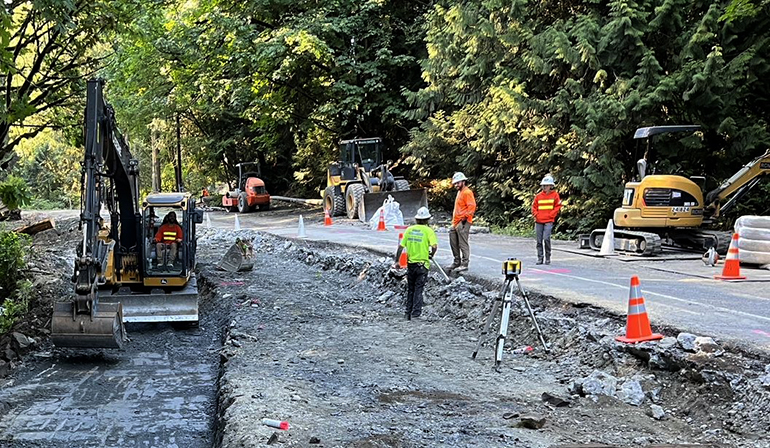
Crews scrape back multiple layers of old pavement from NE Woodinville Duvall Road before excavators are brought in to dig a large construction pit in its place. (Photo July 2023)
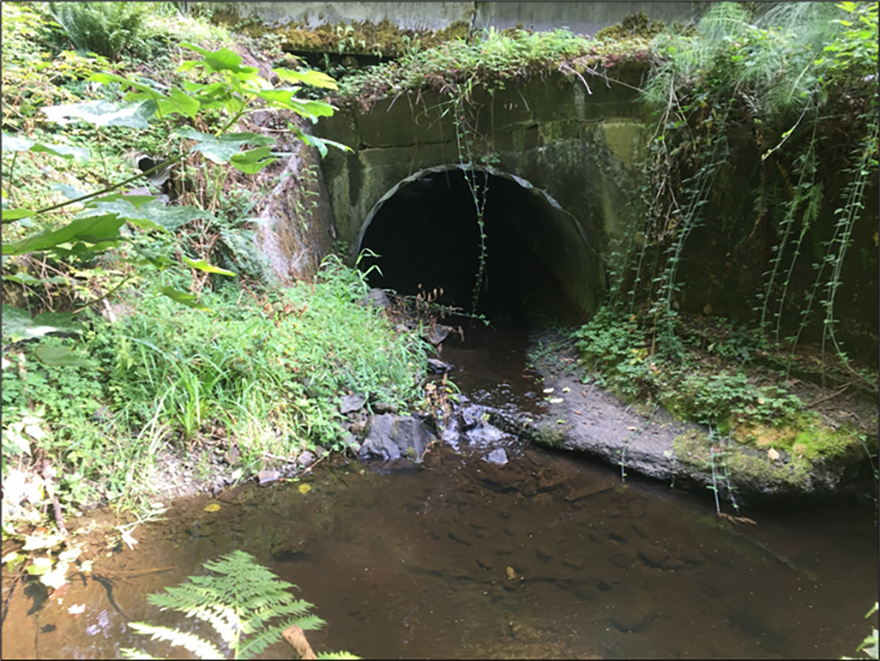
This is the previous metal pipe culvert looking upstream. Most of the year the water moves very fast through the metal pipe into the stream. Over time this high-intensity, swift water created a drop between the culvert and the streambed. This hole prevented fish from being able to jump high enough into the culvert so they can continue to swim further upstream. (Photo May 2019)
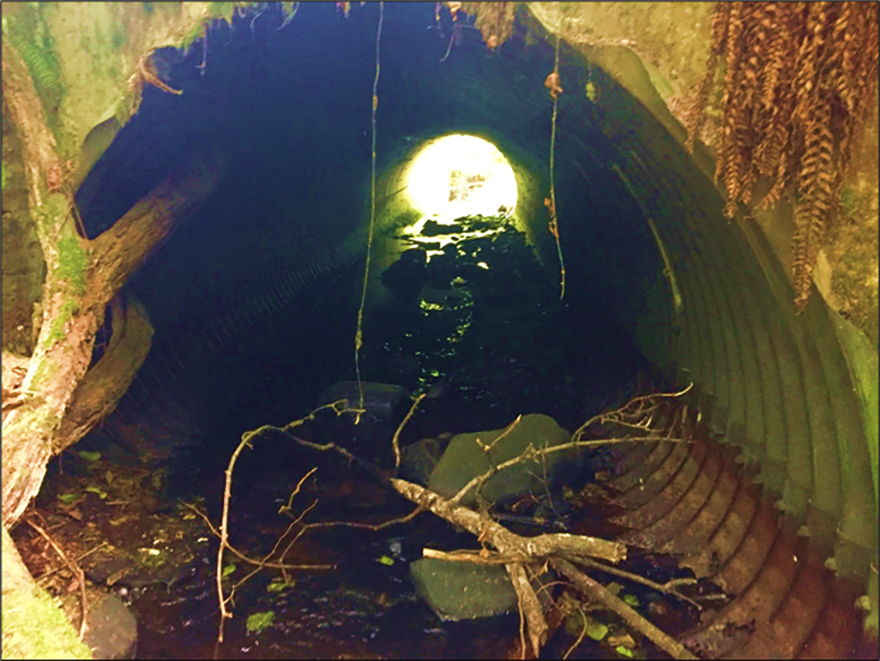
A closer look at the previous metal culvert that carried Tuck Creek under NE Woodinville Duvall Road at 172nd Street. This culvert was rusted out along the bottom. (Photo: September 2019)
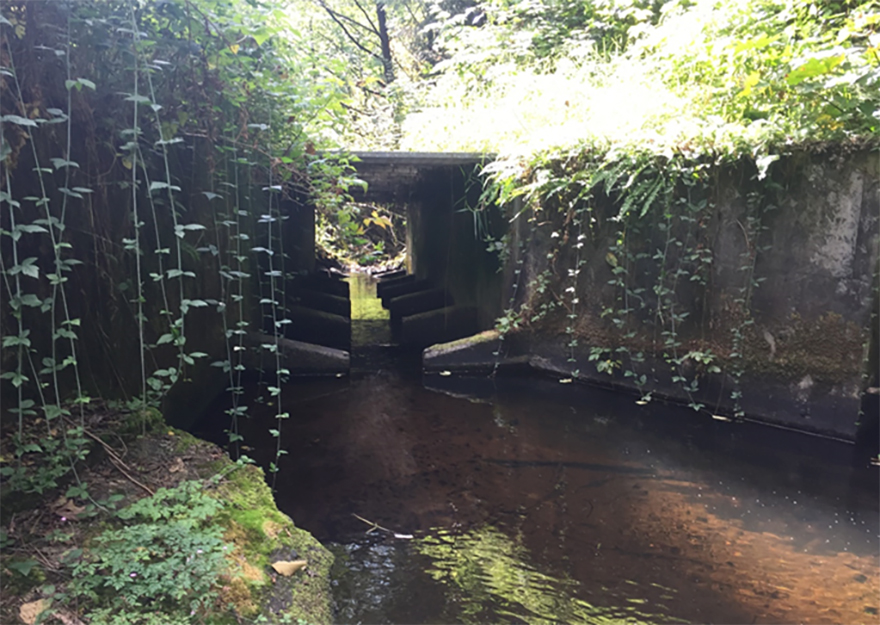
View of the concrete fishway looking downstream from the previous culvert pipe. This fishway was installed in the 1980’s to help migrating fish. Fish that use this ladder mostly swim upstream. The fishway was considered a partial fish barrier because the far end of the fishway (where fish enter) is too high above the stream. (Photo taken: September 2019)

 Translate
Translate
